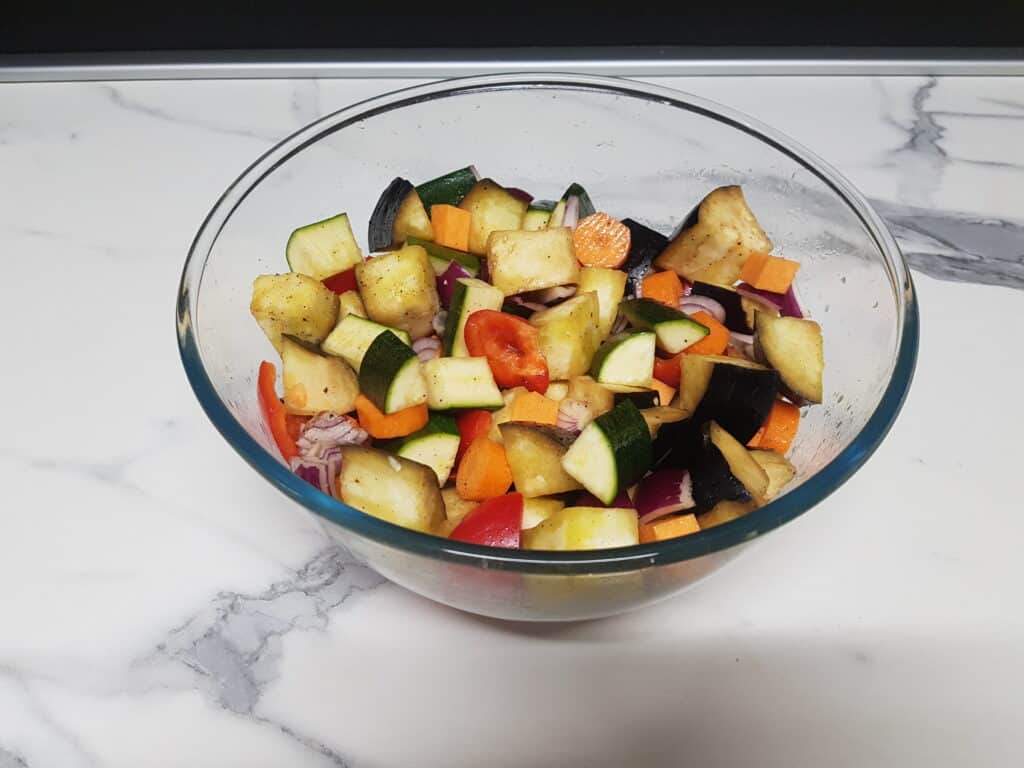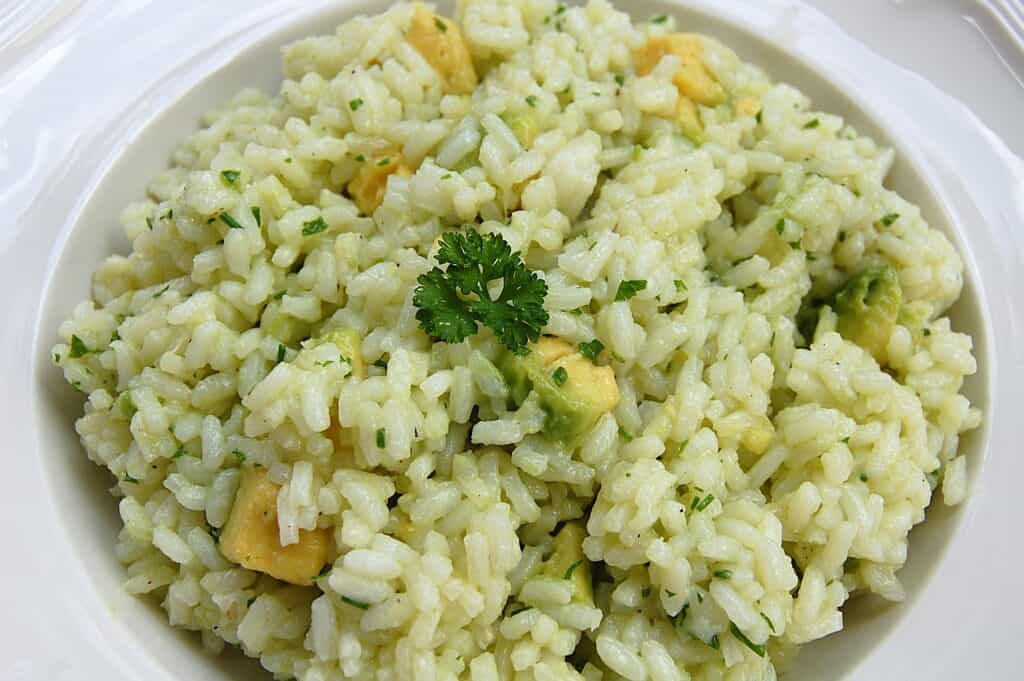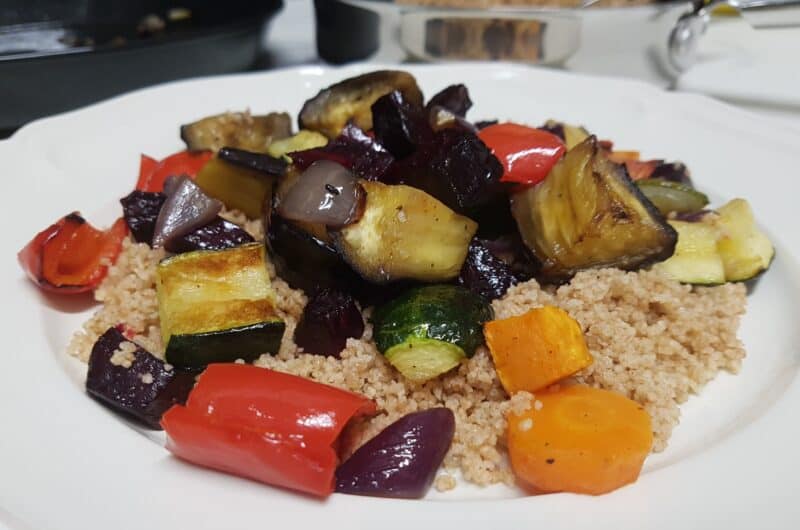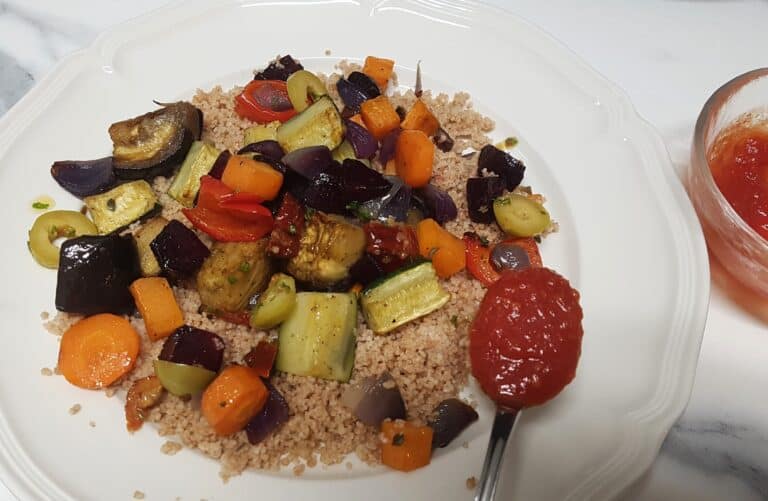This roasted vegetable couscous is healthy, delicious and a real crowd-pleaser! Vibrantly colourful and a little exotic, this dish consists of oven-roasted aubergines, red peppers, courgettes, carrots, red onions, beetroot, and sweet potato, arranged on a bed of wholemeal farro couscous. You can’t get much healthier than that, and just look at those colours! Red, green, and two shades of orange and purple! I topped it all off with some special finishing touches – a garnish of green olive rings, chopped sundried tomatoes and a delicious homemade sweet and sour sauce.

The grainy texture of couscous appeals to most people, and it can be eaten hot, warm, or cold, depending on the occasion and the time of year. You can use any kind of couscous in this recipe. Feel free to customise or swap the vegetables based on what’s in season and what you have available.
Preparing couscous is ridiculously easy – you don’t even need to cook it – you just add hot water. Follow the manufacturer’s cooking instructions on the packet. For this roasted vegetable couscous recipe, I tossed the vegetables in a little oil and roasted them in the oven. The result is an easy-to-prepare yet rather impressive dish, requiring minimum effort and readily available ingredients.
For a quick weeknight dinner, just skip the garnish, and you’ll have dinner on the table in 30 minutes!

All about couscous
What is couscous?
Couscous, also spelled cuscus and kuskus, is the traditional dish of the Berbers, an ethnic group of North Africa (Morocco, Tunisia, and Algeria) and West Africa. The word couscous comes from the Berber word keskas which refers to the traditional steamer the couscous is cooked in. In Morocco, the term couscous refers to the whole dish, usually consisting of meat and vegetables cooked in a delicious broth, served on a bed of semolina granules known as smida.
The couscous granules or smida are made by moistening and rolling the hard part of durum wheat semolina, the part that resisted the grinding of the millstone, into little balls of about 3 mm in diameter. In North Africa, couscous is traditionally cooked in a couscoussière, also known as keskas in Arabic, where the stew slowly cooks in the base, and the couscous granules are placed in a steamer which sits on top of the pan. This allows the granules to absorb the flavours that rise from the broth as steam.
Where to find couscous
Today you’ll find couscous at most supermarkets or grocery stores. It’s usually in the grains, pasta, and rice aisle or in the international food section. You’ll probably find even more than one kind. Apart from plain wheat semolina couscous, I also found farro, kamut, and wholemeal wheat semolina couscous.
How to cook couscous
North Africans don’t eat instant couscous. They steam the couscous in a keskas over the meat and vegetable broth. However, couscous has become a popular dish all over the world and, as its popularity has spread, so have simplified methods of making and cooking it. If you live in Europe or the States, you’ll most likely find and use instant couscous, which gives very satisfying results to those of us who weren’t born into a family of North African origin.
Couscous, as we know it, is widely consumed in many Mediterranean and Middle Eastern countries. Apart from the North African variety, there’s also Israeli couscous, which is much larger, and Lebanese couscous. In the Mediterranean and the Middle East, vegetables like aubergines, peppers, and courgettes grow in abundance and are often served on a bed of couscous. Eaten all year round, couscous is eaten hot or warm in the winter months and sometimes served chilled in salads in the summer.

How to make Roasted vegetable couscous
You’ll find the exact quantities of each ingredient as well as step-by-step instructions with photos in the recipe card at the bottom of this page.
For this recipe, I roasted the aubergines in the oven along with all the red peppers, courgettes, carrots, red onions, and sweet potatoes. I tossed and roasted the beetroot separately so that it wouldn’t dye all the other vegetables pink. This combination of vegetables is great for roasting, and their flavours and colours complement each other perfectly.
Prepare and roast the vegetables

- Wash, trim and cut your vegetables into 1 inch (2,5 cm) pieces. I cut the beetroot and the sweet potato into slightly smaller pieces because they take a little longer to cook.
- Next, put the vegetables into a large bowl and toss them in a couple of tablespoons of extra virgin olive oil. Season them with unrefined sea salt and black pepper.
- Transfer the vegetables to an oven tray lined with baking paper, or tart tins. Spread the vegetables out in a single layer. Roast them on the 2nd shelf of the oven at 230 °C for 25 – 35 minutes, turning them halfway through cooking.

Prepare the couscous
Instant couscous usually just requires rehydrating with hot water. It’s best to read the manufacturer’s instructions on the back of the packet for optimal results. The usual procedure is to weigh the couscous and then pour hot water over it. Most manufacturers specify that the water needs to be very hot but not boiling. You should then cover the pan with a lid and leave it to stand for 10 minutes or so. When all the water has disappeared, and the couscous is rehydrated, use the prongs of a fork to gently separate the grains. You can salt the water or use vegetable stock for extra flavour. I usually salt the water only slightly because the roasted vegetables are already bursting with flavour.

How much couscous per person?
If you are serving this roasted vegetable couscous as a main course, calculate about 100 g per person. As a side dish, 70 – 80 g is probably sufficient.

Finishing touches
This dish is truly delicious just as it is, with plain couscous and oven-roasted vegetables. However, because it was going on the buffet at my daughter’s engagement party, I wanted to make it really special, so I added a garnish of chopped sundried tomatoes and green olives and made a simple but delicious sweet and sour sauce to pour over the top.
The olives I used were large green ones which I pitted and then sliced into rings. I have a big bag of artisan sundried plum tomatoes which I bought in September at the fruit and vegetable market in San Remo, Italy. I used 5 halves for this recipe. Rehydrate them by putting them in a bowl of hot water for half an hour. Drain them and then pat them dry. Roughly chop the sundried tomatoes and add them to the olive rings.
Tip
If you want to keep rehydrated dried tomatoes for longer, then it’s best to soak them in a mixture of 1 part vinegar and 4 parts water. The procedure is the same. Soak for 30 minutes, drain and then pat dry. You can then season them with crushed garlic, freshly chopped parsley, and a drizzling of extra virgin olive oil. I often add capers as well because they go well with sundried tomatoes. I always keep some rehydrated tomatoes on hand- they’re great for snacking on or for putting in sandwiches and wraps etc. They’ll keep in the fridge for a week or so.


How to make sweet and sour sauce
To make the sweet and sour sauce, you need 100 g of tomato sauce (passata) diluted with about 20 grams of water. Don’t use concentrate for this recipe because it is far too strong in flavour. Put the sugar and the vinegar into a small saucepan and bring to a boil. Lower the heat to a minimum as soon as it starts to boil. Add a pinch of salt, stir and simmer for a minute or so. This will allow the strong vinegary flavour to mellow and the sugar and salt to dissolve. Add the tomato sauce (passata), stir well, and set aside.
North Africans use harissa to season their couscous. If you want it to be more authentic, you could make a harissa paste. You’ll find a recipe for that at mymoroccanfood.com.
How to serve roasted vegetable couscous
Put the couscous on a serving platter or individual plates and spread it out. Put the roasted vegetables on top of the bed of couscous. Garnish by sprinkling the olives and sundried tomatoes over the roasted vegetables. Put the sauce in a sauceboat or small bowl so that everyone can serve themselves at the table. Serve warm or cold.

How to store leftover roasted vegetable couscous
This chunky roasted vegetable couscous is great if you need a meal for the following day too. It keeps very well in the fridge. Put any leftovers in an airtight container in the fridge, where they will keep for 2 – 3 days.
Can you freeze it?
Yes, you can. Allow the couscous and roasted vegetables to cool down to room temperature before freezing to avoid condensation, which will cause sogginess. Freeze the couscous in meal-sized portions and store them in airtight containers. Label the containers with the date and contents, then freeze them for up to 3 months.
How to reheat roasted vegetable couscous
Reheat the couscous in a wide, preferably non-stick pan. Put a lid on the pan to keep the moisture in, and warm it up slowly on a low heat. Add a tablespoon or two of water if it seems a bit dry.
How to reheat from frozen
To reheat frozen roasted vegetable couscous and make it taste as fresh as possible, follow these tips:
- Defrost the couscous thoroughly. The best way to preserve texture and flavour is to let the couscous thaw slowly in the fridge overnight. If you’re short of time, you can microwave it on a low defrost setting.
- Since couscous can dry out a bit while you’re reheating it, add a small amount of water or broth. Reheat as described above, stirring occasionally until warmed through. Alternatively, you could reheat it in the microwave.
- To help restore the brightness and freshness of the dish, you could add a drizzle of extra virgin olive oil and a sprinkle of fresh parsley after reheating.
I’m sure you’ll love this roasted vegetable couscous recipe! If you try it, I’d love to hear about it! Let me know in the comments below, or take a quick pic and share it on social media. Don’t forget to tag me on Instagram or Facebook @vegan_hot_stuff – I love seeing your re-creations!
Frequently asked questions
Can I use different vegetables?
Yes, you can. I’m a great believer in using whatever you have on hand. Some other vegetables that you could use are pumpkin squash, broccoli, yellow pepper, green pepper, cherry tomatoes, etc.
Can I make roasted vegetable couscous ahead of time?
Absolutely. Roasted vegetable couscous can be made in advance and stored in an airtight container in the fridge for up to 3 days. Just reheat it before serving, or enjoy it cold as a salad.
Is roasted vegetable couscous gluten-free?
Couscous is traditionally made from wheat, so it is not gluten-free. However, you can substitute it with a gluten-free grain like quinoa or millet for a similar texture.
What type of couscous should I use for roasted vegetables?
You can use regular couscous, wholemeal couscous, spelt couscous or even pearl couscous for a slightly different texture. Just follow the cooking instructions on the package, as they may vary depending on the type.
Is couscous with roasted vegetables healthy?
Yes, couscous with roasted vegetables is generally a healthy dish, especially if prepared with fresh ingredients and a small amount of oil. Roasted vegetables provide dietary fibre, which helps with digestion, regulates blood sugar, and keeps you feeling full longer. Wholemeal couscous has more fibre than regular couscous. Vegetables like red peppers, sweet potatoes, carrots, courgettes, aubergines, and beetroot are packed with vitamins and minerals.
What can I add to couscous for flavour?
To add more flavour to couscous, you could use vegetable broth instead of water. However, a little salt is all that’s needed for couscous if served with roasted vegetables and a homemade harissa sauce or sweet and sour dressing.
How do I keep the couscous from clumping?
To avoid clumping, fluff the couscous with a fork as soon as it’s cooked. A drizzle of olive oil also helps to keep the grains separate.
I hope you liked this recipe! If you did, it would be great if you could give it 5 stars and leave a comment below! It helps other readers to find my content and posts and ultimately makes my blog more successful! Thank you so much for your support! Deborah xx
Before you go, maybe you’d like to have a look at some other delicious vegan recipes.




Would you like to receive my recipes as soon as I publish them? Subscribe below!










